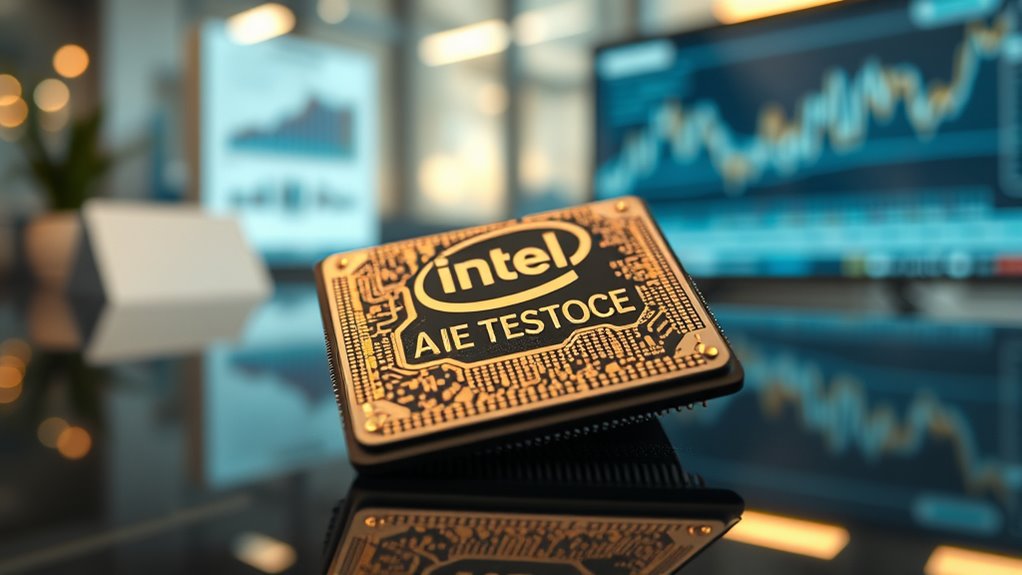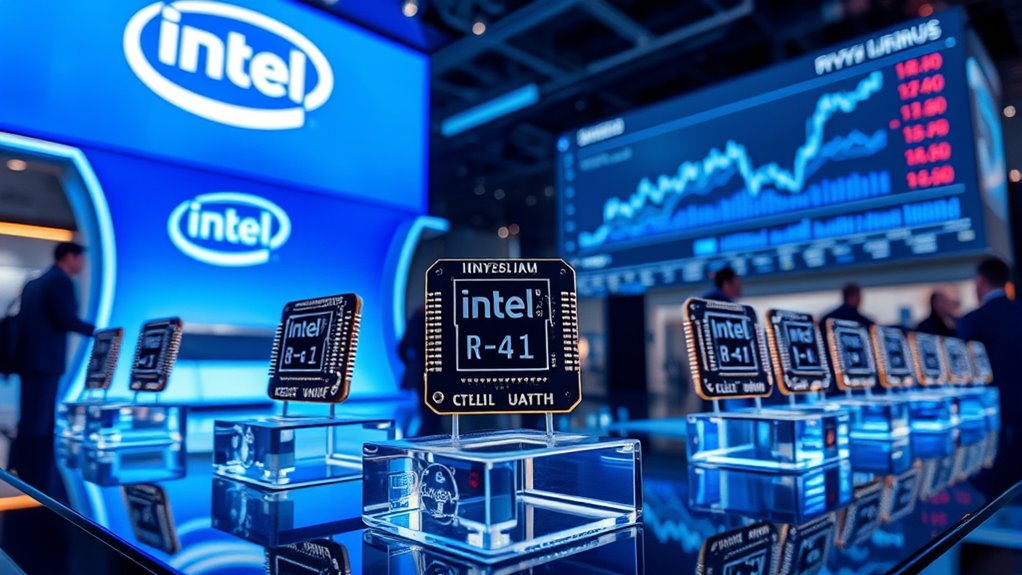Intel has invested heavily in new AI chips to compete in a growing but tough market dominated by NVIDIA and AMD. Despite technological advancements, they struggle to gain significant market share due to fierce rivalry and supply chain issues. Their revenue growth remains sluggish, as high R&D costs and industry disruptions slow profit gains. If you want to understand how Intel’s innovative yet challenging path impacts its future, there’s more to uncover behind these hurdles.
Key Takeaways
- Intel’s new AI chips aim to compete with NVIDIA and AMD but face challenges in gaining significant market share.
- Despite technological advancements, Intel struggles to translate AI chip innovation into substantial revenue growth.
- Market competition, supply chain disruptions, and geopolitical tensions limit the commercial success of Intel’s AI hardware.
- Heavy R&D investments increase costs, impacting profitability amid sluggish sales and industry-wide chip shortages.
- Future success depends on differentiating products and forming strategic partnerships to overcome competitive and logistical hurdles.

Despite Intel’s efforts to lead the AI chip market, the company faces ongoing revenue challenges that threaten its growth prospects. As you look into the AI hardware landscape, you’ll notice that Intel has invested heavily in developing innovative AI chips designed to outperform competitors. These advancements aim to position Intel as a dominant player in a rapidly evolving industry. However, the market competition remains fierce, with companies like NVIDIA, AMD, and emerging startups continually pushing the envelope with more powerful and specialized AI hardware. This intense rivalry makes it difficult for Intel to secure a significant share of the growing AI market, despite its recent product launches.
Intel’s AI chip push faces fierce competition, making market share and revenue growth difficult despite heavy investments.
You might observe that Intel’s new AI chips are built to cater to diverse applications, from data centers to edge devices. But even with these targeted solutions, capturing market share proves challenging because other players have already established strong footholds. NVIDIA, for example, has become synonymous with AI hardware, thanks to its highly optimized GPUs and software ecosystem. AMD is also gaining ground with its competitive offerings, making the AI hardware space more crowded and complex for Intel to navigate. As a result, even with cutting-edge technology, Intel struggles to differentiate itself sufficiently to attract large-scale enterprise customers or secure long-term contracts.
Furthermore, the revenue challenges stem not only from stiff competition but also from broader industry shifts. The demand for AI hardware is growing, but supply chain disruptions, chip shortages, and geopolitical tensions have added layers of difficulty. This environment makes it harder for Intel to scale production efficiently, impacting sales and profit margins. You may also see that Intel’s financial reports reveal a slowdown in revenue growth, indicating that despite its technological advancements, the company hasn’t yet translated innovation into sustained financial gains.
In addition, market competition pushes Intel to continually invest in research and development, which increases expenditure without immediate revenue returns. While innovation is essential, the investment strain can cut into overall profitability, especially when sales don’t meet expectations. For you, this means that Intel’s future success depends on how well it can differentiate its AI hardware offerings, forge strategic partnerships, and navigate the complex competitive landscape. Until then, revenue challenges linger, and the company remains under pressure to prove that its latest AI chips can truly shift the balance in its favor amidst relentless market competition. Moreover, the industry’s growth is also influenced by regional factors, such as supply chain disruptions, which further complicate Intel’s efforts to capitalize on new opportunities.
Frequently Asked Questions
How Do Intel’s AI Chips Compare to Competitors’ Offerings?
You’ll find that Intel’s AI chips deliver solid AI performance, though they often lag behind competitors like NVIDIA in sheer processing power. Their market positioning aims to catch up by focusing on broader data center integration and versatility. While Intel’s chips are improving, they still face stiff competition, especially in high-end AI workloads. Overall, Intel’s offerings are promising but haven’t yet matched the dominance of their rivals.
What Specific Revenue Figures Are Impacted by AI Chip Sales?
Your revenue takes a hit when AI chip sales fall short of expectations, like a ship losing its wind. Specifically, lower AI sales hurt Intel’s market share and squeeze profit margins, leading to a decline in overall revenue figures. These chips are essential in boosting profitability, so if sales slow, you’ll see a direct impact on how much money Intel makes, affecting the company’s financial health.
Are There Any Upcoming Partnerships Related to Intel’s New AI Technology?
You should watch for partnership rumors suggesting AI collaboration, as Intel’s new AI technology could attract strategic alliances soon. These collaborations might involve major tech firms or cloud providers, boosting Intel’s AI chip adoption. While no official announcements are confirmed yet, staying alert to industry news can help you spot potential partnerships that could influence the AI market and Intel’s growth trajectory.
How Does Intel Plan to Address Supply Chain Issues Affecting Revenue?
You might worry that supply chain disruptions and manufacturing delays hinder Intel’s revenue growth. To counter this, Intel actively diversifies its supplier base and invests in advanced manufacturing technology to guarantee resilience. They also strengthen relationships with key partners and optimize logistics to reduce delays. By taking these proactive measures, Intel aims to minimize the impact of supply chain issues and sustain its production capabilities, ultimately supporting revenue stability and growth.
What Are the Long-Term Strategic Goals for Intel’s AI Division?
Intel aims to lead AI innovation by developing advanced chips that improve performance and efficiency. You should focus on market expansion to reach new industries and clients, ensuring long-term growth. The company’s strategic goals include strengthening AI capabilities, fostering partnerships, and investing in emerging technologies. By prioritizing these areas, Intel plans to stay competitive and drive sustained success in the rapidly evolving AI landscape.
Conclusion
As Intel rolls out revolutionary AI chips, you realize the road ahead is riddled with revenue riddles. While innovation ignites interest, persistent profit problems pose a hurdles. To thrive, Intel must quickly adapt and ace its approach, aligning advanced architecture with aggressive strategies. By balancing bold breakthroughs with business brilliance, Intel can turn challenges into chances, charting a course for continued success. Stay savvy, stay strategic, and watch Intel’s inspiring journey unfold.









